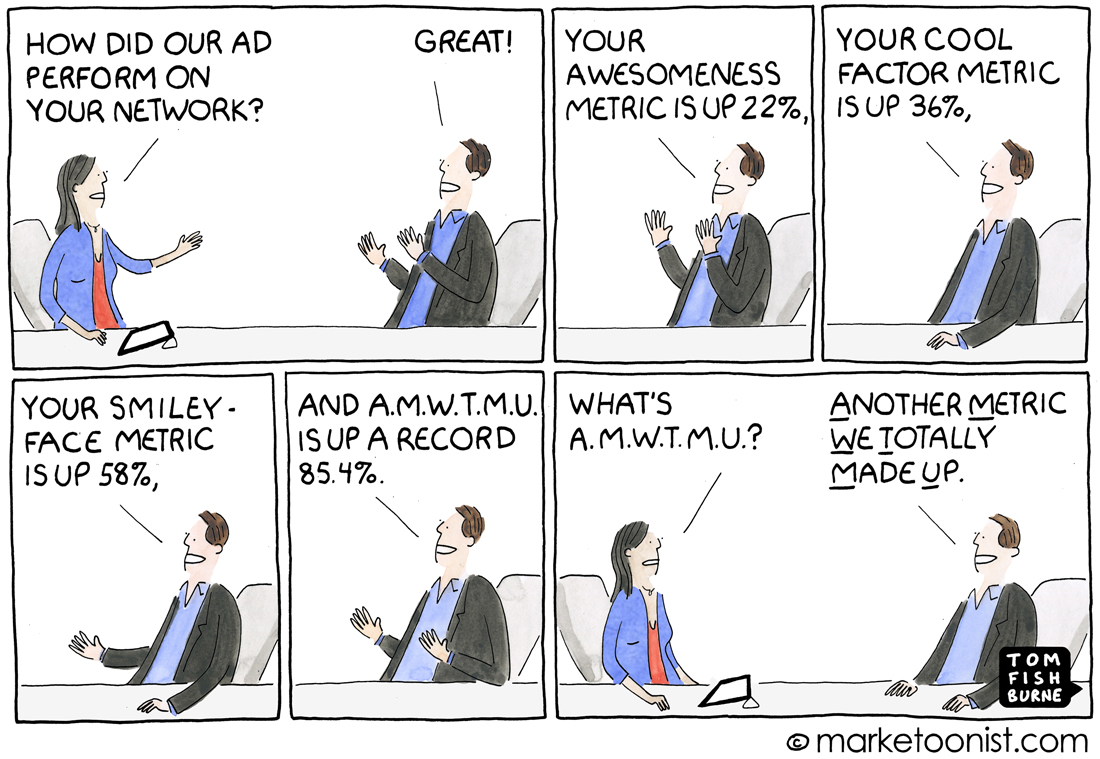Marketing metrics are for math-haters who sell snake oil.
Marketing metrics are for math-haters who sell snake oil.
“Seriously, I do math all day long. Why is it so hard to make sense of these metrics? They’re just numbers!”
“Aren’t marketing metrics just ways to sound like you have a clue when marketing is one big pot of trial and error plus a dash of fake-it-till-you-make-it bravado mixed in?”
“Aren’t these the same communications majors in college (you know, the hardcore partiers finishing their homework the night before) who wound up in sales and marketing because they could talk a pigeon off a ledge (thanks to all that party socializing)…?
…while I busted my ass creating technology that helps make the world go round?”

“Isn’t it obvious that they’re still drunk from college?…You’re seriously insulting my intelligence here.”
That may be true (forgive me if I am), but in all my years of marketing consulting for IT tech companies, I’ve learned that most tech folks don’t know how to collect and review the metrics around their marketing investment.
They also tend to be a bit secretive about this…If this is you, please know you’re far from alone.
While finding a cartoon that succinctly described most people’s conception around metrics (useless AND superficial!), I landed on Marketoonist’s great article regarding them. Please read it if you have time.
HOWEVER, what I want to draw your attention to (after the cartoon that I sincerely hoped made you snort coffee out of your nose or at least elicited a strong head nod), is a comment made by a Jann Mirachandani regarding the article.
See how weird and weedy being on the internet can get? I just LOVE it! (Yes, I read Amazon product reviews for entertainment in my spare time. Need a quick laugh? Go review surfing, you know where. Yes, you really should.)

Who is this person? (Not a f***ing clue) Why aren’t they famous?
I couldn’t have said it better myself.
So, first, why do these numbers (metrics) matter?
Because they tell you whether what you’re spending your money on is actually doing what you want it to do.
If you’re like 45% of other small businesses, you have no idea if and how your marketing dollars are performing, and that, my friends, is a true horror show in the making.

A little something for all of your horror movies fans out there, (which I conveniently mixed in with a little Craigslist).
So, so wrong and you’re welcome, but I digress…
Why is not knowing if your marketing is doing the job you, literally, paid it to do problematic?
You might have already been wondering this for the past ten months.
Because if you can’t tell what marketing strategy, tactic, tool is contributing the most to increasing your sales, then you also don’t know which ones aren’t contributing a god**** thing.
This haze around your marketing investment directly causes these sucky problems:
- Wasting money

- Bad marketing company investment
- Poor understanding around your company’s S.W.O.T. (strengths, weaknesses, opportunities, and threats)
Basically, the very things that tracking and deciphering marketing metrics would tell you (e.g. what’s working and what is basically me heating my house by burning $100-dollar bills?).
“What if I’ve never seen math like this before and like why doesn’t 2 + 2 = 4 anymore?”
Great question. To recap: metrics are for collecting and measuring data but you still need a human to help you interpret it. Think of if more like space, as in every time you try a new marketing strategy or step, it’s the equivalent of going to the moon.
This moon voyage has a lot of variables (climate, rocket design, astronaut sneakers’ weight, etc.) that must be considered and evaluated before you leave planet earth. It’s important to have a benchmark. Since you’re going to go to the moon multiple times, it makes sense to track all the factors and the objectives for the trip every single time.
Then, over time, once you’ve built up enough historical data, you’ll have your benchmark, which makes it easier to see how your marketing techniques measure up.
If you don’t have much historical data (for whatever reason), then the next thing will help guide you immensely.
Set Clear Goals – Define Your Key Performance Indicators (KPI’s)
It’s time to make some goals, my friends.
It’s important to know that marketing tactics are constantly changing. AND what your company measures for may not be a useful metric for another business.
To help guide you in setting your KPIs, consider whether you need answers to the following questions. (Hint: you probably do.)
- Do you need to know how many sales came in from your last promotion?
- Do you need to determine your audience demographics to better narrow down your marketing approach?
- Or, do you simply need to justify, to your financial department, that direct mail is an effective marketing strategy? (OMG. IT IS ALREADY!!!)
Whatever your ultimate marketing goals (and KPIs) are, make sure they are realistic, easily measured, and actually indicate business growth. In other words, more ground, less gloss.
For example, an increase in web traffic may seem like a good goal, but does it translate to increased sales? You need to be able to tell if that uptick in traffic resulted in any additional revenue.
What if you have no idea where to start in picking out your metrics?
Keep it simple and start with these three-key metrics.

It goes without saying that you may want a bigger screen to review your metrics rather than awkwardly huddling around an iPad/tablet with three other co-workers…
The Big Three of Metrics
Imagine that you decided to last minute pitch your marketing idea to the sharks on ABC’s hit show, “Shark Tank.”
What are the top three numbers they’re going to ask you to deliver in rapid succession?
1. What are your sales? – Sales Revenue (SR)
To know how effective your marketing is, you have to understand your sales revenue.
After all, no one wants to spend money on something that isn’t generating money in return.
Kind of like that hot tub you put in your backyard instead of getting that egress window that would enable you legally count your basement as another “room” when you decide to sell it…priorities, right?
To calculate this number, track your total sales for the year. Then, subtract it from the total revenue earned via your inbound or outbound marketing tactics. Pretty straightforward, right?
2. What is your cost per lead? – Customer Acquisition Cost (CAC)
Basically, how much is it costing you to acquire a new customer?
To determine this, you need to calculate all your expenses such as labor, technology and software, and general overhead for your inbound practices, advertising costs, distribution, and sales and marketing labor for your outbound marketing.
Then, divide it by the number of customers you acquired through your marketing efforts. Still fairly simple, right?
3. What is the long-term potential? – Customer Lifetime Value (CLV)
Sharks go for consistent long-term growth NOT for wasting time on short-term gains and trends. That would be distasteful (and reckless).
To figure out your CLV, use this formula:
Average sales per customer X # of times customers make a purchase per month/year X average retention time in months/years for your average customer.
By keeping an eye on this KPI, it will help you see whether or not your existing customer base needs a little more time and attention to feel the love.
In addition to knowing which metrics are useful, it’s also helpful to know which ones are a total waste of time. Avoid them.
Metric Time Wasters
Even marketing guru, Neil Patel, suggests you avoid these numbers due to their misleading and time-sucking wasteful ways:
- Facebook fans and Facebook likes:
Great for teenage social media addicts and for those of us wanting a quick dopamine hit to pull another long day at the office, Or if you’re trying to get a book deal (even though you’ve never written one before) but you managed to get over 30,000 likes on your FB page. Here’s the truth, FB fans and likes are virtually meaningless. It doesn’t tell you why that person’s a fan or like your page or if they’re going to buy your product or service, let alone why that particular FB post/ad made them push the buy (“converted”) button. Again, there is no direct way to correlate likes and dollars earned on Facebook as of now. (Please see the Marketoonist article that called Facebook for having unreliable and sometimes flat out wrong metric reports.
- Total links:
Backlinks are when one website links to another and hopefully, it’s other websites linking to yours. (Do you know what helps with this? Really great content.) Though it also helps when you do the same for others, (which I’ve masterfully illustrated this throughout our marketing educational journey).The purpose of backlinks is that it helps your Search Engine Optimization (SEO), which again gets you found on the wild west that is the internet. However, don’t waste your time trying to amass thousands of them (and besides it’s a cheap trick). Focus instead on getting more relevant, high-quality links since those will usually be to other sites that your clients and prospects actually spend time on.
- Traffic and pageviews:
Just like links and FB likes above, total numbers of traffic and pageviews doesn’t tell you many valuables things about those who visited and what part of the sales funnel they’re in. Are they looking to press a button and buy? Or are they still doing more research before they commit? Don’t waste any more time on this data. Before I leave you today, let me just say again, (and yet again), that it’s most valuable and important to be a human first and to let your clients and prospects be humans first.
Turning your clients into numbers is fairly dehumanizing, which is decidedly not cool. So, be cautious not to lose yourself in analyzing and tracking data. Remember to keep a face with those numbers.
I’ll end by sharing a quote from one of my favorite human beings: Donald Miller of Storybrand , who once said this:“Marketing can be a technical job, right? Some days can feel like an endless parade of spreadsheets, analytics, and checklists.
And of course, those things are part of any good strategy. But when we focus too much on them, we over-systematize our marketing. As a result, we lose sight of the deeply human reasons that motivate every buying decision.
When people buy things, they’re not acting as perfectly rational human beings. The best marketing is overwhelmingly human and speaks to the emotional aspects of our decision making. What challenge do you help your clients overcome? How are you helping them become the person they want to be? When we answer those questions, we invite clients into a story!
When a person feels like they can trust you—when they truly feel you’re guiding them to a successful outcome—they’ll follow your lead. Because you’re offering more than just a product or a price point. You’re offering them transformation.”Stay tuned for five must have marketing tactics that’ll lead to more success in your marketing.
Got Marketing Questions? We can help.
By clicking this button, you submit your information to Scott Growth Strategies, who may use it to communicate with you regarding this and other services.

Based in Minneapolis, MN with offices in Fargo, ND.